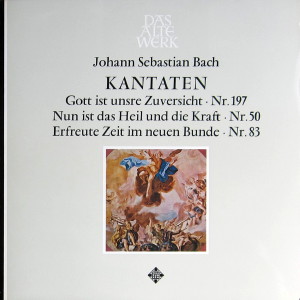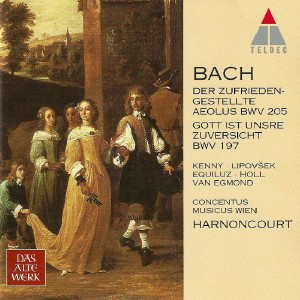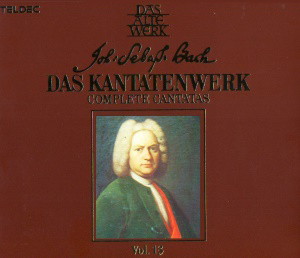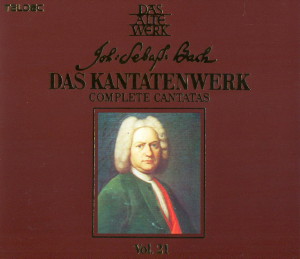 |
1 LP -
SAWT 9539-B - (p) 1969
|
 |
| 1 CD -
0630-12321-2 - (c) 1996 |
 |
| 2 CD -
8.35284 ZL - (c) 1987 |
 |
| 2 CD -
8.35363 ZL - (c) 1989 |
|
| Johann
Sebastian Bach (1685-1750) |
|
|
|
|
|
|
|
| Kantate "Nun ist das Heil und
die Kraft", BWV 50 |
|
3' 37" |
A1 |
| für
Doppelchor (8stg.); Oboe I/II/III;
Trompete I/II/III; Pauken; Violine
I/II//Viola; Orgel; Continuo
(Violoncello, Violone) |
|
|
|
Kantate
"Erfreute Zeit im neuen Bunde", BWV 83
|
|
19' 45" |
A2 |
| für
Soli: Alt, Tenor, Baß; Chor; Oboe I/II;
Horn I/II; Violine Solo; Violine I/II;
Viola; Continuo (Violoncello, Violone
und Orgel) |
|
|
|
Kantate "Gott ist
unsre Zuversicht", BWV
197
|
|
28' 20" |
B1 |
| für
Soli: Sopran, Alt, Baß; Chor; Oboe
d'amore I/II; Oboe I/II; Fagott
obligato; Tromba I/II/III; Pauken;
Violine I/II; Viola; Continuo
(Violoncello, Violone und Orgel) |
|
|
|
|
|
|
|
| Solisten
der Wiener Sängerknaben, Sopran
und Alt |
|
|
| Kurt
Equiluz, Tenor |
|
|
| Max
van Egmond, Baß |
|
|
|
|
| Wiener
Sängerknaben - Chorus
Viennensis / Hans
Gillesberger, Leitung |
|
|
|
| Concentus Musicus
Wien |
|
|
| -
Jürg Schaeftlein, Barockoboe,
Barockoboe d'amore |
-
Alice Harnoncourt, Solovioline |
|
| -
Karl Gruber, Barockoboe,
Barockoboe d'amore |
-
Walter Pfeiffer, Violine |
|
| -
Bernhard Klebel, Barockoboe,
Barockoboe d'amore |
-
Peter Schoberwalter, Violine |
|
| -
Otto Fleischmann, Barockfagott |
-
Stefan Plott, Violine |
|
| -
Ernst Mühlbacher, Naturhorn |
-
Josef de Sordi, Violine |
|
| -
Hermann Rohrer, Naturhorn |
-
Kurt Theiner, Tenorbratsche |
|
| -
Josef Spindler, Clarintrompete |
-
Nikolaus Harnoncourt, Violoncello |
|
| -
Richard Rudolf, Clarintrompete |
-
Eduard Hruza, Violone |
|
| -
Hermann Schober, Clarintrompete |
-
Herbert Tachezi, Orgel |
|
| -
Kurt Hammer, Barockpauken |
|
|
|
|
| Nikolaus
Harnoncourt, Leitung |
|
|
|
Luogo
e data di registrazione
|
| Vienna (Austria)
- settembre
1967 |
|
Registrazione
live / studio
|
| studio |
Producer
/ Engineer
|
Wolf
Erichson
|
Prima Edizione CD
|
-
Teldec "Das Alte Werk" - 0630-12321-2 -
(1 cd) - 72' 51" - (c) 1996 - ADD - (BWV
197)
- Teldec "Das Alte Werk" - Kantatenwerk
Vol. 13 - (2 cd) - 38' 30" + 29' 11" -
(c) 1987 - AAD - (BWV 50)
- Teldec "Das Alte Werk" -
Kantatenwerk Vol. 21 - (2 cd) - 39' 06"
+ 41' 10" - (c) 1989 - ADD - (BWV 83) |
|
Prima
Edizione LP
|
Telefunken "Das
Alte Werk" - SAWT 9539-B - (1 lp) - 41'
42"
- (p) 1969
|
|
|
An Introduction by
Christoph-Hellmut Mahling
|
The isolated, powerful
and broadly conceived cantata movement
for double choir and instruments “Nun
ist das Heil und die Kraft..."
("Now is come salvation and strength..
.") cannot yet be placed by
musicologists with certainty in any
particular period of Bach’s creative
activity. Equally undecided is the
question of its original purpose.
Since its text is taken from the
epistle reading for St. Michael’s Day
(Revelation 12, 10), it would seem
right to assume that we are dealing
with a choral movement originally
intended as part of a cantate for this
festival. The question of its time of
composition is likewise impossible to
answer with certainty. Even though a
number of criteria hitherto seemed to
suggest the time around 1740, the most
recent investigations make it appear
quite conceivable that it belongs to
the year’s cycle of cantatas for
1723/24, or even to a later, fifth
year’s cycle.
Irrespective of these historically
important and interesting questions,
the fact still remains that this
choral piece must be counted among the
most mighty of Bach’s entire oeuvre.
Its theme, representing in its
firmness and concentration the final
victory of God over evil, symbolizing
strength through the interval steps
rising through the third, fourth and
fifth to the octave, seems
omnipresent, as the one dominating
principal idea. It is joined
contrapuntally by an agitated
quaver-semiquaver motif which, through
its sequential downward movement over
the word "verworfen" ("cast down"),
lets this overthrown condition be made
vividly clear, especially in contrast
to the rising theme heard at the same
time. The figure consisting of a
quaver and two semiquavers in fanfare
character, providing the dominant
rhythmic and motoric element in the
piece, represents the victorious
conclusion of the struggle. The
indictment of the evil enemy is given
particular prominence through a rising
chord of the seventh. After the theme
has been presented in all four voices
of the first choir, the second choir
enters, now presenting the theme in
inversion, in "block" fashion as it
were, against the agitated sections of
the first choir. At the same time the
theme shines forth in its original
form in the first trumpet. A similarly
assertive presentation of the theme is
to be found a few bars later. After
the cause of rejoicing has again
become clear in the calling out of the
two choirs to one another, the first
of the two sections into which this
piece is exactly divided (68 bars
each) comes to an end. The second
section, a “repetition” of the first
with intensified expression, presents
the theme first of all split up
between the first and second choirs,
in order to let it reappear again
radiantly in a double fugue exposition
- the original form and the inversion
of the theme being heard together. The
fanfare motif of the oboes is here
heard for the first time in the
trumpets. The further course of the
writing corresponds to that of the
first section, though in considerably
denser form and intensified in its
expression. This so unique and
impressive cantata movement then comes
to a close in a radiant D major chord.
The cantata “Erfreute Zeit im neuen
Bunde” was first performed on
the 2nd February 1724 in Leipzig, and
thus belongs to the first complete
yearly cycle of cantatas. It is
further assumed (though exact
clarification is still necessary) that
it was also heard again in 1727. It is
uncertain who wrote the text, though
Picander’s authorship cannot be
altogether dismissed. The cantata’s
content consists of a favourite motif
of the period in general and of Bach’s
in particular: longing for death, and
the certainty that it cannot harm the
believer but is only to be regarded as
a "state of transition,” as it were,
to a new life full of peace and rest.
In accordance with this, Simeon’s song
of praise (Luke 2, 29-32) - in the
Leipzig liturgy usually sung as a
versicle by the choir before the
collect - occupies the central place
in the work: "Intonazione (Nunc
dimittis) e Recitativo,” i. e. bible
text and commentary are linked to one
another, or rather alternate with each
other. In skillfully contrapuntal,
agitated two-part writing the
instruments "accompany" the simple,
"liturgical" melody of the Intonation.
It is this above all that lets it
stand out so palpably in its calmness
and clarity against the recitative
sections, in which it is urgenty
reminded that fear of death is
completely without cause. This "core"
of the cantata is enclosed by two
arias accompanied by solo violin for
alto and tenor respectively. In their
joyful agitation they are meant to let
us feel the impatience - expressed
through continuous semiquaver figures
in the first aria and likewise
consistently maintained triplets in
the second - of the believer in his
yearning for death. The recitative
following the tenor aria also promises
a blessed death to him who might still
feel uncertainty in his belief in
Christ. The fourth verse of the
chorale usually sung in the
vesper service of this festival, "Mit
Fried’ und Freud’ ich fahr dahin,"
forms the conclusion. Whether the
assumption is correct that Bach has
based the first three movements of the
cantata, which form a powerful musical
unit, on the Italian concerto form -
as their key sequence might also
suggest - and merely added the last
recitative and the chorale for the
sake of completeness as it were,
cannot be decided here. Such an
intention on Bach’s part cannot,
however, be excluded as a possibility.
The relatively lavish orchestral
forces of the wedding cantata "Gott
ist unsre Zuversicht" are enough
in themselves to let us suppose it was
heard during the wedding ceremony of a
notable personality. Divided into two
sections, one of which was performed
before the wedding and the other after
it, it really amounts to two separate
cantatas linked together by the same
main idea. The two arias of the second
part have been adapted from an
incomplete cantata for Christmas Day
"Ehre sei Gott in der Hohe."
Furthermore, it would not seem
impossible that the first part is also
based on borrowings from other
cantatas. The time of its composition
is uncertain. According to most recent
research, however, the years 1736/40
can be assumed with the greatest
probability to be correct. Only the
two arias mentioned above might well
have been written already in the years
1727/29.
The big opening chorus, beginning with
a fugato and written with a powerful
simplicity, is laid out in the ‘da
capo’ form usually reserved for
arrias, through which its solemnity is
yet further increased. The joyful
certainty that God will lead
everything to the best possible
conclusion if we trust Him is recalled
in the bass recitative that follows
and the alto aria that is so beautiful
in its sound, above all through its
use of the oboe d’amore as a solo
instrument, and radiates such pleasing
calmness except for its more agitated
middle section. The first part ends
with the advice not to err from the
path predetermined by God (bass
recitative) and the prayer that God
may, through His grace, grant
awareness of and steadfastness in true
love. In the second part, to be
performed after the wedding ceremony,
the bridal couple are personally
addressed, so to speak, and assured of
God’s providence. This is achieved to
begin with in a bass aria full of
tender agitation whose special
character is further emphasized by its
instrumentation; then, after a
recitative of introductory character
in a soprano aria in Siciliana rhythm
with the character of a lullaby,
accompanied by a solo violin and two
oboes d’amore, in which restrained joy
can be truly felt. After a bass
recitative full of confidence, this
part again closes with a chorale
setting, probably one of the most
beautiful that Bach ever wrote.
The cantata in the broadest sense of
the word - whether as the church
cantata or the patrician, academic or
courtly work of musical homage and
festivity - accompanied the Arnstadt
and Mühlhausen organist, the Weimar
chamber musician and court organist,
the Köthen conductor and finally the
Leipzig cantor of St. Thomas’-Bach-all
through his creative life, although
with fluctuating intensity, with
interruptions and vacillations that
still are problems to musicological
research down to this very day. The
earliest preserved cantata (“Denn du
wirst meine Seele nicht in der Hölle
lassen”) probably dates, if it really
is by Bach, from the Arnstadt period
(1704) and is still completely under
the spell of North and Central German
traditions. In the works of his
Mühlhausen years (1707-08) - psalm
cantatas, festive music for the
changing of the council and a funeral
work (the “Actus tragicus") - we sense
for the first time something of what
raises Bach as a cantata composer so
much higher than all his
contemporaries: the ability to analyse
even the most feeble text with regard
to its form and content, to grasp its
theological significance and to
interpret it out of its very spiritual
centre in musical "speech" that is
infinitely subtle and infinitely
powerful in effect. In Weimar
(1708-17) new duties pushed the
cantata right into the background to
begin with. It was not until the Duke
commissioned him to write "new pieces
monthly" for the court services that
Bach once more turned to the cantata
during the years 1714-16, on texts
written by Erdmann Neumeister and
Salomo Franck. Barely thirty cantatas
can be ascribed to these two years
with a reasonable degree of certainty.
It is most remarkable that, on the
other hand, no courtly funeral music
has been preserved from the entire
Weimar period, although there must
have been a considerable demand for
such works. It is conceivable that
many a lost work, supplied with a new
text by Bach himself, lives on among
the Weimar church cantatas.
In the years Bach spent at Köthen
(1717-23), on the other hand, it is
the composition of works for courtly
occasions of homage and festivity that
come to the fore, entirely in keeping
with Bach’s duties as Court Conductor.
It is only during the last few months
he spent at Köthen that we find him
composing a series of church cantatas
once again, and these were already
intended for Leipzig. It was in
Leipzig that the majority of the great
church cantatas came into being, all
of them - according to the most recent
research - during his first few years
of office at Leipzig and comprising
between three and a maximum of five
complete series for all the Sundays
and feast days of the ecclesiastical
year. But just as suddenly as it
began, this amazing creative flow, in
which this magnificent series of
cantatas arose, appears to have ended
again. It is possible that Bach’s
regular composition of cantatas
stopped as early as 1726; from 1729 at
the latest it is evident that other
tasks largely absorbed his creative
energy, particularly the direction of
the students’ Collegium Musicum with
its perpetual demand for fashionable
instrumental music. More than 50
cantatas for courtly and civic
occasions have indeed been recorded
from later years, but considered over
a period of 24 years and compared with
the productivity of his first years in
Leipzig they do not amount to very
much. We are left with the picture of
an enigmatic silence in a sphere which
has ever counted as the central
category in Bach's creative output.
But we only need cast a superficial
glance at the more than 200 of the
master’s cantatas that have come down
to us in order to see that this
conception of their position in Bach’s
total output is fully justified. Bach
has investigated their texts with
regard to both their meaning and their
wording with incomparable penetration
piercing intellect and unshakeable
faith, whether they are passages from
the Bible, hymns, sacred poems by his
contemporaries or sacredly trimmed
poetry for courtly occasions. He has
transformed and interpreted these
texts through his music with
incomparable powers of invention and
formation, he has revealed their
essence and, at the same time
translatted the imagery and emotional
content of each of their ideas into
musical images and emotions. The
perfect blendin of eword and note, the
combination of idea synthesis and
depiction of each detail of the text,
the joint effect of the baroque
magnificence of the musical forms and
the highly differentiated attention to
detail, the skillful balance, between
contrapuntal, melodic and harmonic
means in the service of the word and,
not least, the inexhaustible fertility
and greatness of a musical imagination
that is able to create from the most
feeble ‘occasional’ text a world of
musical characters - all this is what
raises the cantata composer Bach so
much higher than his own and every
other age and their historically
determined character, and imparts a
lasting quality to his works. It is
not their texts alone and not their
music alone that makes them immortal -
it is the combination of word and note
into a hgher unit, into a new
significance that first imparts to
them the power of survival and makes
them what they are above all else:
perfect works of art.
|
|
Nikolaus
Harnoncourt (1929-2016)
|

|

|
|